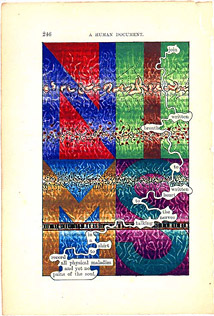"Humumentism": The Works and Ideas of Tom Phillips by Marvin Sackner
Marvin Sackner is co-founder of the Ruth and Marvin Sackner Archive of Concrete and Visual Poetry.
For nearly twenty years, I have collected the artistic, literary, and musical works of Tom Phillips, whom I have known as a friend and as his patron. To express succinctly my appreciation and description of his work, I utilise the word "Humumentism," one that I coined from Phillips's seminal, visual-poetic artist's book, A Humument. Although it might appear brash to ascribe an art form to an individual rather than a group of artists, I feel pressed to do so on several counts, not least because his multi-leveled creative accomplishments so discomfort the critical sector that interprets them. Phillips has always worked in parallel styles and themes, in sharp contrast to most successful artists, whose art is easily identified by a single style of the moment with changes, if ever, progressing serially over time. Human beings generally feel more at ease with an artist who has a single style and are put off by having to adjust to an artist whose style, thematic material, and medium all abruptly change.
For those unfamiliar with the works of Phillips, a first viewing of a large body of his work in which disparate styles and themes appear side by side might bring about a sense of cacophony or awe. But if the effort is taken to delve into Phillips's oeuvre, then each of these styles and themes can be demonstrated to have a long-standing lineage in time. One does not need to become an art detective to enjoy Phillips's work; rather, his individual works can be visually and intellectually enjoyed if the viewer does not attempt to place the whole in the context of a single art movement. Herein lies the foundation for a partial description of "Humumentism": artistic creativity carried out in parallel styles and themes outside the popular conception of serial artistic presentations.
Our first encounter with Phillips's work took place at his 1975 retrospective exhibition held at the Kunsthalle in Basel. On a summer vacation trip to Switzerland, Ruth and I visited the Kunsthalle as an art-related vacation activity. We did not go there especially to see the Phillips exhibition, which featured works by an artist barely known to us. At first, we wondered whether Tom Phillips was an artist or a group of artists. But as we looked at the pictures more closely, we saw wonderful clusters of artistic styles bound to each other. We experienced an epiphany that has not been repeated in our artistic adventures: we recognised the unique artistic inventiveness of work encompassing all of contemporary and modern art history. This was evidenced by images representing visual poetry, abstract expressionism, constructivism, visual/verbal art, expressionistic portraits, pointillism, color stripes and calligraphic markings, among others. All of them touched favorably upon our personal aesthetic. We stayed several hours at the exhibition and returned the next day for several more.
For us the highlight of the exhibition were the pages of A Humument, an artistically treated 1892 Victorian novel by W.H. Mallock, A Human Document, displayed between two large panes of glass to enable recto-verso viewing and reading. This work imparted a profound delightful, visual and intellectual experience, and day-dreams about owning this work, which was well beyond our financial reach (the sale price was listed at the information desk of the Kunsthalle). We resolved to collect prints made by Phillips which we could afford and to meet this future star of our collection. Subsequently, on this same trip, we made our first purchase of Phillips, Ein Deutsches Requiem, After Brahms, a suite of prints, and A Humument as a series of prints. The next year we met Tom, later purchased the original pages of A Humument, and have continued acquiring revised pages as well as paintings, drawings, objects, books and prints.
I consider A Humument to be the most important artist's book of the twentieth century. It constitutes the basis for my definition of Phillips's work as "Humumentism". Phillips's artistic treatment of this book, in which each page has been painted, typed upon, drawn, or collaged to leave clusters of the original printed text as new poetry, is epitomised by the new poetry Phillips culled from the printed text of the first page. "The following sing I a book, a book of art, of mind art, and that which he did, reveal I." Fragments of Humument texts remain a prominent stylistic feature of Phillips's paintings and drawings to the present, including his illustrations for Dante.
Although Phillips leaves the impression that his selection of Mallock's novel was fortuitous, I believe its choice was deliberate, either as a conscious or subconscious decision on his part. For example, the story begins with the reading of an imaginary journal in manuscript, reminiscent of the imaginary tack taken by Phillips in producing A Humument. The title of the novel is relevant to Phillips's work. It recalls the idea of Humanism, which the German philosopher Schiller emphasised as the idea of creative individual thought forming the basis of personal truth. Humanism also implies study of the humanities, i.e., literature, philosophy, art, poetry, music, etc., as distinguished from the sciences. Throughout his artistic, literary, musical and poetic career, Phillips has excelled in these humanistic activities. Thus, "Humumentism" is an art form that integrates humanistic activities through individual creative thought that falls outside the current popular conception of artistic presentations.
Phillips traces his artistic lineage from his teachers back to their teachers and so to Raphael himself, but I believe that his work is better seen as an extension of early twentieth-century art movements: the Russian avant-garde, Italian Futurism, and British Vorticism. These movements were marked by the integration of humanistic activities that provided visual, poetic, spiritual, and intellectual aspects of viewing and interpretation not unlike the multilevelled pleasures encountered in the works of Tom Phillips.

